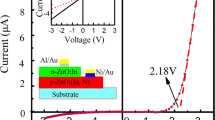Abstract
ZnO:N epitaxial films have been grown by reactive magnetron sputtering. The effect of annealing in atomic oxygen on the structural and electrical properties of the ZnO:N films has been studied by X-ray diffraction, atomic force microscopy, Hall effect measurements, and X-ray photoelectron spectroscopy. By annealing at temperatures from 500 to 700°C, we have obtained p-type ZnO:N films with a resistivity of ∼57 Ω cm, hole mobility of ∼2.7 cm2/(V s), and hole concentration of ∼6.8 × 1017 cm−3. X-ray photoelectron spectroscopy results suggest that the p-type conductivity of the films is due to a decrease in the concentration of (N2)O and V O donors.
Similar content being viewed by others
References
Lee, Ch.-T., Fabrication methods and luminescent properties of ZnO materials for light-emitting diodes, Materials, 2010, vol. 3, no. 4, pp. 2218–2259.
Zhang, S.B., Wei, S.-H., and Zunger, A., Intrinsic n-type versus p-type doping asymmetry and the defect physics of ZnO, Phys. Rev. B: Condens. Matter Mater. Phys., 2001, vol. 63, paper 75 205.
Laks, D.B., Van de Walle, C.G., Neumark, G.F., and Pantelides, S.T., Acceptor doping in ZnSe versus ZnTe, Appl. Phys. Lett., 1993, vol. 63, pp. 1375–1377.
Look, D.C., Electrical and optical properties of p-type ZnO, Semicond. Sci. Technol., 2005, vol. 20, pp. S55–S61.
Tu, M.-L., Su, Y.-K., and Ma, C.-Y., Nitrogen-doped p-type ZnO films prepared from nitrogen gas radio-frequency magnetron sputtering, J. Appl. Phys., 2006, vol. 100, paper 053 705.
Tan, S.T., Chen, B.J. Sun, X.W., et al., Realization of intrinsic p-type ZnO thin films by metal organic chemical vapor deposition, J. Electron. Mater., 2005, vol. 34, no. 8, pp. 1172–1176.
Pan, M., Nause, J., Rengarajan, V., et al., Epitaxial growth and characterization of p-type ZnO, J. Electron. Mater., 2007, vol. 36, no. 4, pp. 457–461.
Rogozin, I.V., Nitrogen-doped p-type ZnO thin films and ZnO/ZnSe p-n heterojunctions grown on ZnSe substrate by radical beam gettering epitaxy, Thin Solid Films, 2009, vol. 517, pp. 4318–4321.
Nakano, Y., Morikawa, T., Ohwaki, T., and Taga, Y., Electrical characterization of p-type N-doped ZnO films prepared by thermal oxidation of sputtered Zn3N2 films, Appl. Phys. Lett., 2006, vol. 88, paper 172 103.
Yamamoto, T. and Katayama-Yoshida, H., Solution using a codoping method to unipolarity for the fabrication of p-type ZnO, Jpn. J. Appl. Phys., 1999, vol. 38, pp. L166–L169.
Moulder, J.F., Stickle, W.F., Sobol, P.E., et al., Handbook of X-ray Photoelectron Spectroscopy, Eden Prairie: Perkin-Elmer, 1992.
Yan, Y., Zang, S.B., and Pantelides, S.T., Control of doping by impurity chemical potentials: Predictions for p-type ZnO, Phys. Rev. Lett., 2001, vol. 86, paper 5723.
Perkins, C.L., Lee, S.-H., Li, X., et al., Identification of nitrogen chemical states in N-doped ZnO via X-ray photoelectron spectroscopy, J. Appl. Phys., 2005, vol. 97, paper 034 907.
Sun, J.W., Lu, Y.M., Liu, Y.C., et al., Nitrogen-related recombination mechanisms in p-type ZnO films grown by plasma-assisted molecular beam epitaxy, J. Appl. Phys., 2007, vol. 102, paper 043 522.
Wei, P.Z., Yao, B., Li, Y.F., et al., Fabrication of p-type nitrogen-doped MgZnO by depressing N-related donors, J. Korean Phys. Soc., 2008, vol. 53, pp. 3043–3046.
Rogozin, I.V, Georgobiani, A.N., Kotlyarevsky, M.B., and Marakhovskii, A.V., Compensation mechanism for hole conduction in ZnO:N films, Inorg. Mater., 2009, vol. 45, no. 4, pp. 391–398.
Georgobiani, A.N., Gruzintsev, A.N., Volkov, V.T., and Vorob’ev, M.O., Effect of annealing in oxygen radicals on luminescence and electrical conductivity of ZnO:N films, Semiconductors, 2002, vol. 36, no. 3, pp. 265–269.
Author information
Authors and Affiliations
Corresponding author
Additional information
Original Russian Text © I.V. Rogozin, A.N. Georgobiani, M.B. Kotlyarevsky, V.I. Demin, L.S. Lepnev, 2013, published in Neorganicheskie Materialy, 2013, Vol. 49, No. 6, pp. 604–608.
Rights and permissions
About this article
Cite this article
Rogozin, I.V., Georgobiani, A.N., Kotlyarevsky, M.B. et al. Activation of p-type conduction in ZnO:N films by annealing in atomic oxygen. Inorg Mater 49, 568–571 (2013). https://doi.org/10.1134/S0020168513050130
Received:
Published:
Issue Date:
DOI: https://doi.org/10.1134/S0020168513050130



